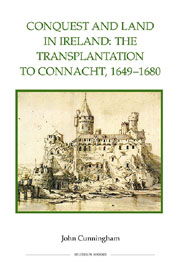Book contents
- Frontmatter
- Contents
- List of maps
- Acknowledgements
- Abbreviations
- Introduction
- 1 Conquest and land in Cromwellian Ireland, 1649–1652
- 2 Towards plantation and transportation, 1652–1654
- 3 The land settlement under threat, 1653–1655
- 4 Enforcing transplantation, 1655–1659
- 5 Transplantation in County Roscommon
- 6 The transplanters and the Restoration land settlement
- Conclusion
- Bibliography
- Index
4 - Enforcing transplantation, 1655–1659
Published online by Cambridge University Press: 05 February 2013
- Frontmatter
- Contents
- List of maps
- Acknowledgements
- Abbreviations
- Introduction
- 1 Conquest and land in Cromwellian Ireland, 1649–1652
- 2 Towards plantation and transportation, 1652–1654
- 3 The land settlement under threat, 1653–1655
- 4 Enforcing transplantation, 1655–1659
- 5 Transplantation in County Roscommon
- 6 The transplanters and the Restoration land settlement
- Conclusion
- Bibliography
- Index
Summary
By the spring of 1655 the Irish government was at last ready to attempt the full implementation of its transplantation policy. Following its uncertain beginnings in the previous year, the effort to transplant former landowners and soldiers was carried out with some degree of success up to the end of the decade. This chapter will explore several key aspects of that process. It is necessary to set the scene by outlining the range of punishments that persons refusing to transplant were liable to. The government's attempts to enforce the transplantation in Dublin and the south-east, the region where it had the most direct involvement, will then be assessed. Here as elsewhere, Fleetwood and his successor Henry Cromwell were largely dependent on the co-operation of local officers and officials. Some insight into the extent to which the members of this vital group went about fulfilling their duties can be pieced together from the surviving sources. The most important of these officials, the two teams of commissioners appointed to oversee the resettlement of the transplanters in Connacht, merit particular attention. Finally, some further account must be taken of Catholic responses to the policy of transplantation from 1655 onwards, particularly those of the Galway townsmen and the Leinster officers. The examination together of these various elements should make it possible clearly to discern why the transplantation scheme ultimately assumed the form that it did.
- Type
- Chapter
- Information
- Conquest and Land in IrelandThe Transplantation to Connacht, 1649-1680, pp. 74 - 99Publisher: Boydell & BrewerPrint publication year: 2011

